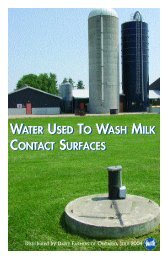Canadian Quality Milk On-Farm Food Safety Program - Centre ...
Canadian Quality Milk On-Farm Food Safety Program - Centre ...
Canadian Quality Milk On-Farm Food Safety Program - Centre ...
You also want an ePaper? Increase the reach of your titles
YUMPU automatically turns print PDFs into web optimized ePapers that Google loves.
<strong>Canadian</strong> <strong>Quality</strong> <strong>Milk</strong><br />
Introduction<br />
Whether cattle are grazing in pastures, passing time in exercise yards, standing in the<br />
milking parlour or lying in their stalls, their environment can pose hazards if improperly<br />
managed. Exposure to chemicals, contaminated water sources, hazardous objects (e.g.<br />
discarded wire, boards with nails), manure and muddy areas can affect cattle health<br />
and, in turn, milk quality and safety.<br />
The proper management of pesticides, animal manure and pests is important to the<br />
production of safe milk and meat. Livestock wastes include potentially harmful<br />
components: nitrates, phosphates, organic material and microbes (i.e., bacteria,<br />
viruses, protozoa and parasites). Improperly handled livestock waste can pollute water<br />
sources, cause diseases, and result in fly outbreaks.<br />
The milk house is the final stop for quality control on the farm. <strong>Milk</strong> safety and quality<br />
can be affected by hazards such as insects and improperly stored cleaning, pest control<br />
and pharmaceutical products.<br />
Best management practices for dairy operation facilities, from simple cleanliness to<br />
overall facility design, can minimize these hazards and keep livestock dry, comfortable,<br />
safe and healthy.<br />
1.1 REGULATORY REQUIREMENTS<br />
The <strong>Canadian</strong> <strong>Quality</strong> <strong>Milk</strong> program is not designed to replace or supercede regulations<br />
pertaining to food safety on dairy farms. As stated in the introduction of this manual, a<br />
farm/producer must be licensed to ship milk by the provincial regulatory authority. The<br />
farm/producer must also meet the minimum acceptable standards set out in the Dairy<br />
Regulations of that province that apply to food safety, as well as any food safety-related<br />
Federal regulations (e.g. feed regulations). As regulations are added or amended in a<br />
province, they will apply to the CQM program.<br />
1.2 PESTICIDES AND CHEMICALS<br />
Pesticide and chemical use on dairy farms must be properly controlled to ensure that<br />
milk and meat are not accidentally contaminated. Pesticides include chemicals used on<br />
crops or pastures, and in and around the milk house and barns.<br />
1.2.1 Pesticide and Chemical Application<br />
<strong>On</strong>ly use registered pesticides. All products used on pastures, crops, feeds and<br />
surrounding land or in farm buildings must be registered for use in Canada. This<br />
includes pesticides used to control rodents and flies.<br />
June 2010 1—3
















